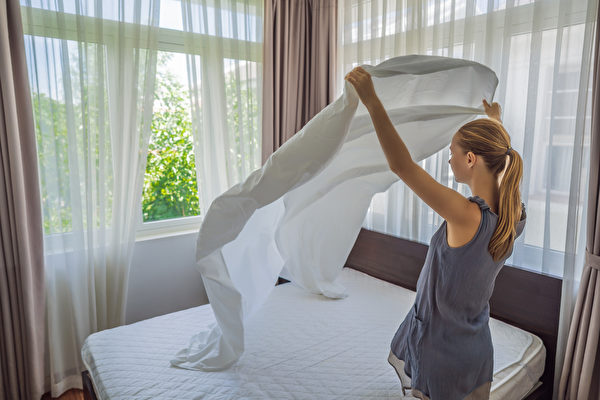In today’s fast-paced world, where people are often working long hours, cleaning bed sheets, pillowcases, and other daily household items has become one of the most easily neglected chores. Experts emphasize the importance of regularly washing bedding and provide guidelines on the proper timing and steps for cleaning these items to help improve sleep environment quality and overall health.
Many individuals spend close to one-third of their lives in bed, yet only a fraction of them opt to change their sheets weekly. According to a survey by the UK bedding supplier Pizuna Linens, 67% of people forget to wash their bedding, 35% do not find it bothersome, 22% lack spare bedding hence infrequent washing, and 38% believe there is no need for more frequent cleaning.
Sleep Advisory research revealed that on average, Americans change their sheets every 24 days. YouGov survey found that only about 28% of Britons choose to wash their sheets weekly, 36% every two weeks, and 4% every two months or longer.
The Sleep Foundation and University of Leicester clinical microbiology professor Primrose Freestone suggest that bed sheets and pillowcases should ideally be washed at least once a week. Regularly cleaning bedding is not only about hygiene but also affects one’s health and sleep quality.
Dr. Freestone explained in a magazine that even after showers before bed, skin sheds millions of cells, secretes oils, and produces around 240 milliliters of sweat each night. These substances serve as breeding grounds for bacteria and microorganisms, which can lead to unpleasant odors when sweat breaks down.
Even if a bed appears “clean,” invisible bacteria, fungi, and other microorganisms from the skin can transfer to sheets, pillows, comforters, or duvets, posing health risks with continued accumulation.
Moreover, skin flakes shed nightly are mites’ food source, thriving in warm, moist bedding. Their excrement acts as a potent allergen, potentially aggravating conditions like eczema, asthma, and allergic rhinitis.
In fact, pillows may harbor fungi such as Aspergillus, impacting the respiratory system of the immunocompromised, and Candida, which can survive on fabric for a month, leading to issues like thrush, urinary tract infections, or yeast infections.
Studies show that pillowcases unwashed for over a week can harbor bacterial colonies 17,000 times more than on a toilet seat, with accumulated dirt, dead skin cells, and bacteria possibly causing more acne.
Experts note that pollutants, dust, pollen, and allergens accumulated on hair and bodies during the day can also transfer to bedding, potentially triggering allergies, affecting breathing, and even reducing bedroom air quality.
Dr. Freestone stressed that besides affecting physical health, a hygienic sleep environment directly impacts sleep quality, with many studies linking sleep quality to heart health and cognitive clarity.
Dr. Freestone and other experts provide correct washing times and methods for bedding, advising to check labels and materials before washing to prevent improper cleaning and damage.
“Bed Sheets and Pillowcases”:
Individuals should ideally wash weekly, but those ill, sweating profusely, or sharing a bed with pets are recommended to wash every three to four days due to faster accumulation of sweat, oils, microorganisms, dead skin cells, and allergens.
They suggest washing at temperatures above 60°C to kill bacteria, fungi, and dust mites; deep disinfection can involve tumble drying or ironing, while dust mite eradication inside pillows may require freezing for at least 8 hours.
“Mattresses”:
It is suggested to vacuum weekly and air mattresses every few days to prevent sweat buildup as a breeding ground for mites. For mattresses with plastic or hypoallergenic protectors, it’s advised to replace the mattress every 7 years for hygiene maintenance.
Furthermore, when cleaning mattresses, using a steam cleaner is recommended by Good Housekeeping to thoroughly sanitize the top, sides, and spring mattresses to kill dust mites, followed by vacuuming to remove their carcasses. Memory foam and heat-sensitive mattresses should avoid steam cleaning to prevent damage but can benefit from sprinkling with baking soda and vacuuming after a few hours.
“Plush Toys”:
Regular disinfection is necessary, especially when toys are dirty, smelly, or if children are sick. Check labels before cleaning to ensure machine washable items, soak plush toys in cold water with appropriate detergent when handwashing. Make sure to air dry thoroughly post wash to prevent bacterial and microbial growth.
“Pillow Fillings”:
Experts recommend cleaning every four to six months, ensuring labels indicate washability due to potential bacterial and mold growth inside fillings. Thorough cleaning and complete drying are essential to prevent fungal growth.
“Blankets and Duvet Covers”:
It is advised to wash every two to four weeks, more frequently if pets sleep on them, as they can trap skin flakes, sweat, and allergens. Check labels for suitability for washing with hot water above 60°C.
For “Down Comforters or Duvets,” cleaning is recommended every two to four months, with label checks required before cleaning, as some materials may need professional cleaning to prevent damage or performance issues. If sharing with pets or children, more frequent washing is recommended to avoid infections or allergic reactions, as mites and microorganisms inside can impact health.

